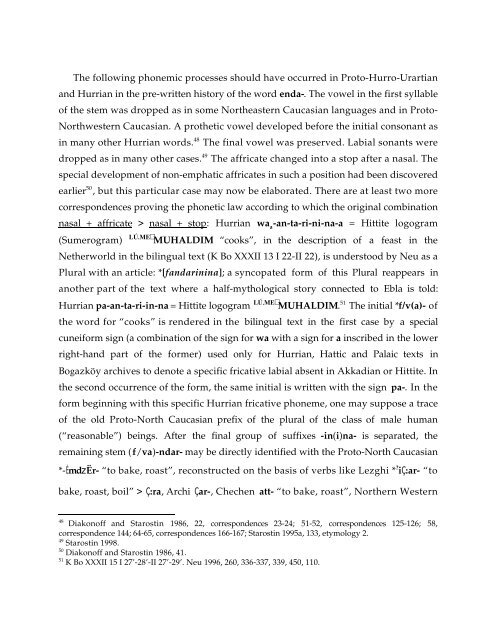Comparative Notes on Hurro-Urartian, Northern Caucasian
Comparative Notes on Hurro-Urartian, Northern Caucasian
Comparative Notes on Hurro-Urartian, Northern Caucasian
You also want an ePaper? Increase the reach of your titles
YUMPU automatically turns print PDFs into web optimized ePapers that Google loves.
The following ph<strong>on</strong>emic processes should have occurred in Proto-<strong>Hurro</strong>-<strong>Urartian</strong><br />
and Hurrian in the pre-written history of the word enda-. The vowel in the first syllable<br />
of the stem was dropped as in some Northeastern <strong>Caucasian</strong> languages and in Proto-<br />
Northwestern <strong>Caucasian</strong>. A prothetic vowel developed before the initial c<strong>on</strong>s<strong>on</strong>ant as<br />
in many other Hurrian words. 48 The final vowel was preserved. Labial s<strong>on</strong>ants were<br />
dropped as in many other cases. 49 The affricate changed into a stop after a nasal. The<br />
special development of n<strong>on</strong>-emphatic affricates in such a positi<strong>on</strong> had been discovered<br />
earlier 50 , but this particular case may now be elaborated. There are at least two more<br />
corresp<strong>on</strong>dences proving the ph<strong>on</strong>etic law according to which the original combinati<strong>on</strong><br />
nasal + affricate > nasal + stop: Hurrian wa a -an-ta-ri-ni-na-a = Hittite logogram<br />
(Sumerogram) MUHALDIM “cooks”, in the descripti<strong>on</strong> of a feast in the<br />
Netherworld in the bilingual text (K Bo XXXII 13 I 22-II 22), is understood by Neu as a<br />
Plural with an article: *[fandarinina]; a syncopated form of this Plural reappears in<br />
another part of the text where a half-mythological story c<strong>on</strong>nected to Ebla is told:<br />
Hurrian pa-an-ta-ri-in-na = Hittite logogram MUHALDIM. 51 The initial *f/v(a)- of<br />
the word for “cooks” is rendered in the bilingual text in the first case by a special<br />
cuneiform sign (a combinati<strong>on</strong> of the sign for wa with a sign for a inscribed in the lower<br />
right-hand part of the former) used <strong>on</strong>ly for Hurrian, Hattic and Palaic texts in<br />
Bo azköy archives to denote a specific fricative labial absent in Akkadian or Hittite. In<br />
the sec<strong>on</strong>d occurrence of the form, the same initial is written with the sign pa-. In the<br />
form beginning with this specific Hurrian fricative ph<strong>on</strong>eme, <strong>on</strong>e may suppose a trace<br />
of the old Proto-North <strong>Caucasian</strong> prefix of the plural of the class of male human<br />
(“reas<strong>on</strong>able”) beings. After the final group of suffixes -in(i)na- is separated, the<br />
remaining stem (f/va)-ndar- may be directly identified with the Proto-North <strong>Caucasian</strong><br />
*-Èmd´zËr- “to bake, roast”, rec<strong>on</strong>structed <strong>on</strong> the basis of verbs like Lezghi * ? iÇ:ar- “to<br />
bake, roast, boil” > Ç:ra, Archi Çar-, Chechen att- “to bake, roast”, <strong>Northern</strong> Western<br />
48 Diak<strong>on</strong>off and Starostin 1986, 22, corresp<strong>on</strong>dences 23-24; 51-52, corresp<strong>on</strong>dences 125-126; 58,<br />
corresp<strong>on</strong>dence 144; 64-65, corresp<strong>on</strong>dences 166-167; Starostin 1995a, 133, etymology 2.<br />
49 Starostin 1998.<br />
50 Diak<strong>on</strong>off and Starostin 1986, 41.<br />
51 K Bo XXXII 15 I 27’-28’-II 27’-29’. Neu 1996, 260, 336-337, 339, 450, 110.





